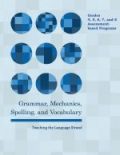Interactive Notebooks Assessment-based Individualized Instruction
Many teachers have found Interactive Notebooks (INBs) to be an excellent addition to their instructional repertoire to teach grade level Common Core Standards. Some teachers have gone “whole hog” with reading, vocabulary, history, science, and math INBs, while others have waded into the water with only one content area. Still others may or may not have dipped their toes into the INB pool and decided that a more traditional approach to content instruction works for them (without the mess and additional time of the INB) To each his or her own…
A number of years ago I decided to experiment with teaching interactive grammar notebooks to my seventh grade ELA students. Like many secondary ELA teachers, I, was skeptical about INBs simply being artsy-fartsy, “cute” projects to prop up teacher egos at Open House. Wrong!
As an author of quite a few grades 4 to high school grammar programs, I began to convert the program content to an INB format used by AVID: Cornell Notes. Cornell Notes is a natural fit in that is designed to be interactive: Students take notes and respond to the content. After the lesson students synthesize the learning.
My personal philosophy is to teach traditional grammar, usage, and mechanics in the reading and writing contexts, so I added on the grammar cartoons of my favorite illustrator, David Rickert with content related questions that required analysis and writing application. I added on simple sentence diagrams to help students practice the grammatical concepts in the context of sentence structure and created practice sentences. After all, practice makes perfect. I used the best foldables on the web (thanks Tangstar) and worked to create graphic organizers that would be less mess and less time-consuming. The foldables were designed to rehearse and synthesize the lesson components with some freedom of choice. I also created bi-weekly unit tests for all 56 lessons, which require students to define terms, identify concepts or skills, and apply their knowledge in original sentences. Done! A great grades 4-8 Common Core State Standards-aligned INB (if I do say so myself). But…
Something was missing: formative assessments for each lesson. How did I know and how would teachers know who would buy my Grades 4-8 Teaching Interactive Grammar Notebook if their students understood each lesson before they took the unit test? How would we know if we needed to go back and re-teach a certain aspect of the lesson? What if some students got it, and some did not? Rather than just move on to the next lesson, we had to know. After all, it’s really not about teaching… it’s about learning.
Like my traditional grammar programs, I added on two short mechanics and grammar formative assessments to each lesson. Now I knew if they got it or not, and who got it and who did not. Done! But…
Something was still missing: assessment-based individualized instruction. I’m always preaching, “Don’t assess if you don’t plan to teach to the assessment” to my ELA and reading intervention colleagues. Time to practice what I preach with my INB. Just like I have in my traditional grammar programs, I added on individualized instructional resources to my Grades 4-8 Teaching Interactive Grammar Notebook: worksheets (each with their own formative assessments), songs, posters, hand-outs, videos, you name it! Problem…
This INB was now a veritable tree-eating monster! With the additional hundreds of pages of resources to individualize instruction–many of which teachers would never use…
I figured it out. I created a section on the Cornell Notes for online links and resources. Now INBs can help teachers individualize instruction so students can “catch up” while they “keep up” with grade level instruction. You’ll love it!
Interested in checking out the author’s Teaching Grammar and Mechanics Interactive Notebook? Click HERE.
Or check out the traditional style Grammar, Mechanics, Spelling, and Vocabulary Grades 4-8 programs to teach the Common Core Language Standards. Each full-year program provides 56 interactive grammar, usage, and mechanics and include sentence diagrams, error analysis, mentor texts, writing applications, and sentence dictation formative assessments with accompanying worksheets (L.1, 2). Plus, each grade-level program has weekly spelling pattern tests
and accompanying spelling sort worksheets (L.2), 56 language application opener worksheets (L.3), and 56 vocabulary worksheets with multiple-meaning words, Greek and Latin word parts, figures of speech, word relationships with context clue practice, connotations, and four square academic language practice (L.4, 5, and 6). Comprehensive biweekly unit tests measure recognition, understanding, and application of all language components.
Grammar/Mechanics, Reading, Spelling/Vocabulary, Study Skills, Writing


